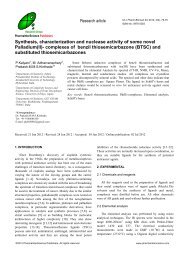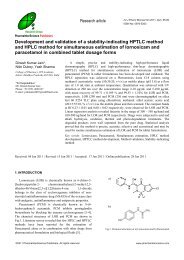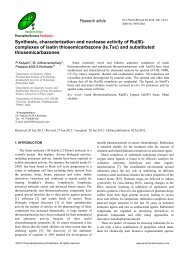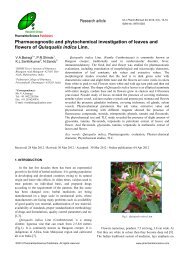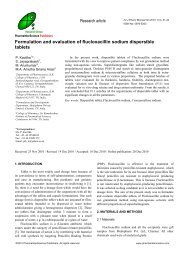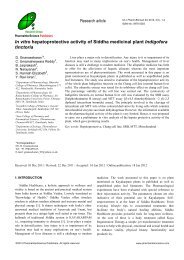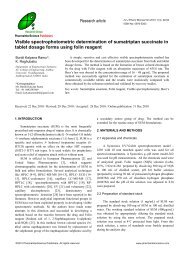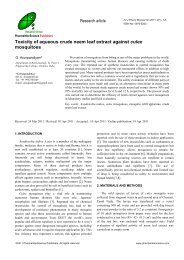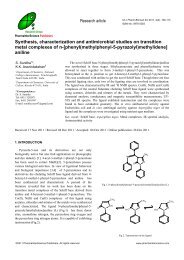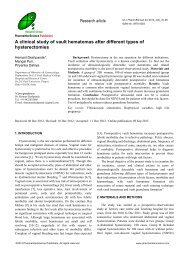Comparision of biofilm production and multiple drug resistance in ...
Comparision of biofilm production and multiple drug resistance in ...
Comparision of biofilm production and multiple drug resistance in ...
You also want an ePaper? Increase the reach of your titles
YUMPU automatically turns print PDFs into web optimized ePapers that Google loves.
M. Dheepa et al., Int J Pharm Biomed Sci 2011, 2(4), 103-107<br />
Table 5<br />
Antibiotic susceptibility pattern <strong>of</strong> the 50 A.baumannii isolates tested are<br />
given <strong>in</strong> this table<br />
Antibiotic<br />
Number (% sensitive)<br />
n=50<br />
Amikac<strong>in</strong> 30 µg 22<br />
Ceftazidime 30 µg 28<br />
Cipr<strong>of</strong>loxac<strong>in</strong> 5 µg 38<br />
Cefepime 30 µg 28<br />
Imipenem 10 µg 46<br />
Pipercill<strong>in</strong> 100 µg 28<br />
Ampicilll<strong>in</strong> + sulbactum 10 µg +10µg 44<br />
Gentamic<strong>in</strong> 10 µg 28<br />
Co-trimoxazole 1.25µg +23.75 µg 32<br />
Doxycyl<strong>in</strong>e 30 µg 52<br />
Piperacill<strong>in</strong> + tazobactum 100 µg + 10 µg 50<br />
Meropenem 10 µg 32<br />
Tobramyc<strong>in</strong> 10 µg 50<br />
Lev<strong>of</strong>loxac<strong>in</strong> 10 µg 62<br />
Aztreonam 30 µg 18<br />
Netilmyc<strong>in</strong> 30 µg 72<br />
Ofloxac<strong>in</strong> 5 µg 24<br />
Table 6<br />
Antibiotic susceptibility results (percentage) <strong>of</strong> A. baumannii isolates<br />
Antibiotics<br />
Resistance <strong>of</strong><br />
Bi<strong>of</strong>ilm positive<br />
isolates N=20<br />
Bi<strong>of</strong>ilm negative<br />
isolates N=30<br />
Amikac<strong>in</strong> 80 73.3 78<br />
Ceftazidime 95 86.6 72<br />
Cipr<strong>of</strong>lox 85 80 62<br />
Cefepime 95 86.6 72<br />
Imipenem 65 70 54<br />
Pipercill<strong>in</strong> 95 93.3 72<br />
Ampicilll<strong>in</strong> + sulbactum 55 66 56<br />
Gentamic<strong>in</strong> 70 70 72<br />
Co-trimoxazole 75 76 68<br />
Doxycyl<strong>in</strong>e 35 56 48<br />
Piperacill<strong>in</strong> + tazobactum 40 50 50<br />
Meropenem 70 66 68<br />
Tobramyc<strong>in</strong> 75 33 50<br />
Lev<strong>of</strong>lox 50 30 38<br />
Aztreonam 85 76.6 82<br />
Netilmyc<strong>in</strong> 20 20 28<br />
Ofloxoc<strong>in</strong> 60 76 76<br />
Table 7<br />
Multiple <strong>drug</strong> resistant patterns <strong>of</strong> A. baumannii<br />
Multiple <strong>drug</strong> comb<strong>in</strong>ations<br />
Number <strong>of</strong> isolates<br />
show<strong>in</strong>g <strong>resistance</strong><br />
Resistance<br />
<strong>of</strong> all<br />
isolates<br />
N =50<br />
Percent<br />
Ak, Ao, Cf, I, Of 31 62<br />
Ak, Ao, I 31 62<br />
Cf, I 33 66<br />
Ak, I, Of 30 60<br />
Ao, Cf, I 33 66<br />
Ak- amikac<strong>in</strong>, Ao- aztreonam, Cf- cipr<strong>of</strong>loxac<strong>in</strong>, I- imepenem, Of –<br />
<strong>of</strong>loxac<strong>in</strong><br />
chloramphenicol 94.7%, amoxicill<strong>in</strong>/clavul<strong>in</strong>ic acid 94.7%,<br />
netilmyc<strong>in</strong> 93.9%, ceftazidime 90.9%, gentamic<strong>in</strong> 87.9%,<br />
pipercill<strong>in</strong>/tazobactam 84.8%, nalidixic acid 84.2%,<br />
tobramyc<strong>in</strong> 75%, imipenem 7.2%, colist<strong>in</strong> 7.1% [10].<br />
106<br />
Another study done <strong>in</strong> Estonia showed 60 % <strong>of</strong> A.<br />
baumanii isolates sensitive to ampicill<strong>in</strong> + sulbactum, 95%<br />
to imepenem <strong>and</strong> meropenum <strong>and</strong> 70 % to amikac<strong>in</strong> [11]. In a<br />
study conducted <strong>in</strong> UK showed <strong>resistance</strong> to piperacill<strong>in</strong> +<br />
tazobactum 39%, imipenam 7%, cipr<strong>of</strong>loxac<strong>in</strong> 46%,<br />
meropenem 0.5%, ceftazidime 46%, pipercill<strong>in</strong> 72%,<br />
gentamic<strong>in</strong> 43%, amikac<strong>in</strong> 21% respectively [12]. Similar<br />
study conducted <strong>in</strong> Ankara <strong>in</strong> 2002 shows the <strong>resistance</strong><br />
rates were 31.2% for netilmic<strong>in</strong>, 44.6% for sulbactamcefoperazone,<br />
53.6% for imipenem, 59.8% for amikac<strong>in</strong>,<br />
59.9% for tobramyc<strong>in</strong>, 74% for cipr<strong>of</strong>loxac<strong>in</strong>, 78% for<br />
gentamic<strong>in</strong>, 79.5% for sulbactam-ampicill<strong>in</strong>, 82.3% for<br />
cotrimoxazole, 84.8% for ticarcill<strong>in</strong>, 87.3% for piperacill<strong>in</strong>tazobactam,<br />
88.1% for ceftazidime <strong>and</strong> 92.1% for piperacill<strong>in</strong><br />
[13].<br />
Another study was conducted <strong>in</strong> USA regard<strong>in</strong>g the multi<br />
<strong>drug</strong> <strong>resistance</strong>. The results showed, about 79.5% (66/83)<br />
were multi-<strong>drug</strong> resistant (MDR) A. baumanii. Among these,<br />
62 were resistant to ceftazidime <strong>and</strong> 66 were resistant to<br />
imipenem. The imipenem resistant isolates (66/83) were also<br />
resistant to kanamyc<strong>in</strong>, amikac<strong>in</strong>, gentamic<strong>in</strong>, streptomyc<strong>in</strong>,<br />
tetracycl<strong>in</strong>e, cipr<strong>of</strong>loxac<strong>in</strong> <strong>and</strong> nalidixic acid [14].<br />
In a study conducted <strong>in</strong> India, Hyderabad Ac<strong>in</strong>etobacter<br />
baumannii showed 77% <strong>resistance</strong> to piperacill<strong>in</strong>-tazobactam<br />
[15]. In another study conducted <strong>in</strong> India, Pune 75% <strong>of</strong> the<br />
isolates were multi<strong>drug</strong> resistant (MDR) <strong>and</strong> <strong>resistance</strong> to<br />
aztreonam 60% <strong>and</strong> for imipenem 29% was noted [16].<br />
In our study bi<strong>of</strong>ilm producers showed <strong>in</strong>creased<br />
<strong>resistance</strong> to Ceftazidime 95%, Cefepime 95% <strong>and</strong> Pipercill<strong>in</strong><br />
95%. A recent study showed significantly higher <strong>resistance</strong> to<br />
cefotaxime, amikac<strong>in</strong>, cipr<strong>of</strong>loxac<strong>in</strong> <strong>and</strong> aztreonam among<br />
bi<strong>of</strong>ilm producers. Non-bi<strong>of</strong>ilm producers showed <strong>in</strong>creased<br />
<strong>resistance</strong> only for netill<strong>in</strong> <strong>and</strong> <strong>of</strong>loxac<strong>in</strong> [7].<br />
5. CONCLUSIONS<br />
In conclusion, cont<strong>in</strong>uous surveillance <strong>of</strong> the <strong>in</strong>-vitro<br />
antimicrobial susceptibility <strong>of</strong> Ac<strong>in</strong>etobacter baumannii<br />
isolates <strong>in</strong> various geographical areas are necessary <strong>in</strong> order<br />
to generate data useful for optimis<strong>in</strong>g empirical antimicrobial<br />
treatment <strong>of</strong> patients with <strong>in</strong>fections that are likely to be<br />
caused by this pathogen. Our <strong>in</strong>vestigation reveals a<br />
simultaneous emergence <strong>of</strong> <strong>resistance</strong> to many antimicrobial<br />
agents when the organisms produce bi<strong>of</strong>ilm <strong>and</strong> represents a<br />
severe threat <strong>in</strong> the treatment <strong>of</strong> hospitalized patients. It is a<br />
challenge to treat <strong>and</strong> also to eradicate this multi<strong>drug</strong><br />
resistant organism because the overall healthcare costs which<br />
are attributed to the treatment <strong>of</strong> bi<strong>of</strong>ilm associated <strong>in</strong>fections<br />
will be much higher. The high rate <strong>of</strong> <strong>in</strong>vitro antibiotic<br />
<strong>resistance</strong> <strong>of</strong> the Ac<strong>in</strong>etobacter baumanii stra<strong>in</strong>s <strong>in</strong>dicate the<br />
importance <strong>of</strong> controlled antibiotic usage <strong>and</strong> appliance <strong>of</strong><br />
hospital <strong>in</strong>fection control measures.<br />
©2011 PharmaInterScience Publishers. All rights reserved. www.pharma<strong>in</strong>terscience.com




